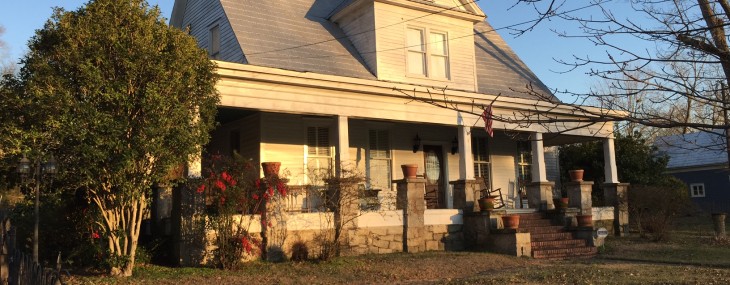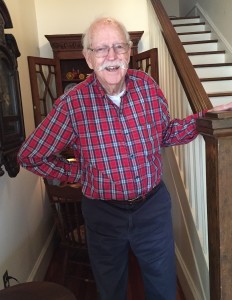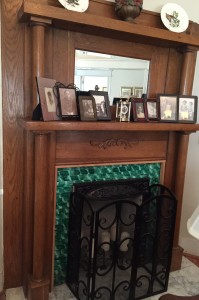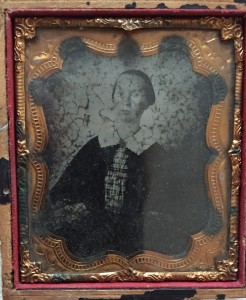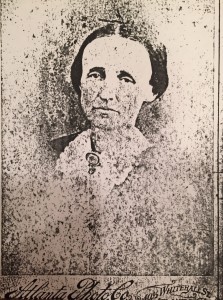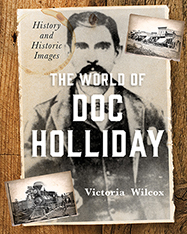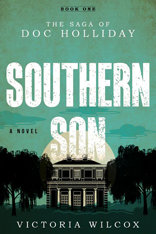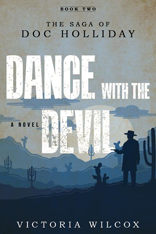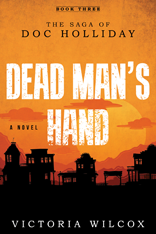Willis Swint was six years-old when his family moved from their hometown of Milner, Georgia to Jonesboro in Clayton County, and into an antebellum cottage across from the tracks of the Macon & Western Railroad. That was in 1933, during the Great Depression, and hobos riding the rails often stopped at the house looking for a meal and maybe some work to pay for another day of hard living. But the old house was used to strangers coming by through the years, from Yankee soldiers during the Civil War to young recruits during two World Wars. Willis liked to think about all the old house had seen, as he spent his growing up years there, finally moving out when he married and started his own home.
He was an older man himself when he moved back to the house on the railroad tracks, hoping to preserve the home and his family’s history. But it was another family’s surprising history that Willis discovered when he and his wife Beverly returned and began renovations on the 150 year-old property – the family of Western legend, Doc Holliday. In an old safe left in the house, they discovered a pile of deeds to the property reaching back to the 1860’s when the home was known as the “Holliday Office House.” The owner then was Captain Robert Kennedy Holliday, uncle of the famous Doc Holliday, and father of Doc’s rumored first love, Mattie Holliday. The home was Captain Holliday’s office, and a place that young Doc would have known and likely visited.
The Holliday Office House was still new when Doc was there: a classic four-room cottage with a sloping roof and a wide front porch and fireplaces in every room. On warm Southern summer days, Captain Holliday may have taken care of business matters on the porch. On chilly winter afternoons, he surely had a fire burning in the fireplaces. And at one time, a portrait of his wife, Mary Anne Fitzgerald Holliday, stood on the stained oak mantel in the parlor.
Mary Anne was the daughter of Irishman James Fitzgerald and niece to Phillip Fitzgerald, who owned a cotton plantation near Lovejoy’s Station, south of Jonesboro. The Fitzgerald plantation would survive the Civil War and inspire Tara in Gone With the Wind, written by Phillip’s great-granddaughter, Margaret Mitchell. Mary Anne, whose family lived in nearby Fayetteville, was only sixteen years-old when she and Robert Holliday eloped to Atlanta to be married by the Catholic priest there. Perhaps they eloped because her family thought her too young to marry; perhaps the family objected to her marrying a protestant boy like Robert Holliday. But although Mary Anne and Robert married young, the marriage lasted and produced seven children. Their oldest daughter, Martha Anne, nicknamed “Mattie,” was close and perhaps romantically involved with her Holliday cousin John Henry, who would later become famous as Doc Holliday. Mattie would become famous in her own way when she entered a convent and took the name Sister Mary Melanie – a name borrowed by her cousin Margaret Mitchell for the heroine of Gone With the Wind, Melanie Hamilton.
That intriguing connection between the Old South and the Wild West is what first inspired my own trilogy novel, Southern Son: The Saga of Doc Holliday, which begins in Georgia during the Civil War and tells the story of John Henry Holliday’s life and loves, and takes the reader back to the Southern world he knew. But how do we know about the portrait of his aunt Mary Anne standing on the mantel in the Holliday Office House in Jonesboro? Because that was one of the discoveries the Swint family made when they set out to renovate the old property and turn it into a modern antiques-filled home.
One of the major projects of the restoration was refinishing the fireplace mantels. Although originally stained oak, the mantels had been painted over many times during the years, and had to be carefully removed, stripped of paint, and restored. When the parlor mantel came down, a little gold-framed photograph dropped to the floor, as if it had slipped behind the mantel and been hidden there. The photograph was an ambrotype, an antique process used during the 1850’s and 1860’s in which a glass plate was coated with a wet, light sensitive substance that was developed and dried to produce a negative image. The image was then mounted against a dark background or coated with a dark varnish to give the illusion of a positive. The ambrotype found behind the Holliday Office House mantel was mounted on black velvet, and showed a beautiful young woman in mid-19th century dress. But who was she?
The answer came from local historian Peter Bonner, who was consulted and quickly recognized the face in the portrait as matching a photograph of an older Mary Anne Fitzgerald Holliday, wife of the owner of the home. With no identification on the photograph, that similarity will likely be all the proof we ever have of the identity of the face behind the fireplace. But in a town as small as Jonesboro was when the photograph was made, in a home owned at the time by Robert Kennedy Holliday, with a portrait strikingly similar to a later photograph of Captain Holliday’s wife, it’s not likely to be anyone else, and the light eyes looking out from the little gold frame are surely Irish blue.
So this is the face that Mattie Holliday knew, and that young Doc Holliday knew as well: a beautiful girl who married young and made a family that became legendary. Little would anyone have guessed, when she and Robert Holliday eloped to Atlanta, how long their legacy would last. And imagine if they hadn’t married – Doc Holliday wouldn’t have had his Mattie, or been kin to Margaret Mitchell, and the Old South and the Wild West would never have fallen in love.
Fun Links
Ambrotype Photography
Macon & Western Railroad History
Margaret Mitchell’s Tara Inspiration
Road to Tara Museum
Peter Bonner’s Historical & Hysterical Tours
Click the book cover below for more info or to order.
